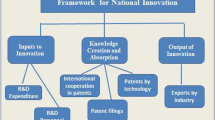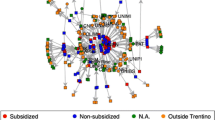Abstract
By tracing the flows of patent citation to prior patents and scientific journal articles, we investigate the sources of knowledge for innovation output in Singapore, a small, highly open economy that has traditionally been significantly dependent on foreign multinational corporations (MNCs). We found that the local production of new knowledge by indigenous Singaporean firms depends disproportionately on technological knowledge produced by MNCs with operational presence in Singapore and scientific knowledge generated by foreign universities. Locally produced new knowledge by indigenous firms and local universities/ public research institutes constitutes an as yet insignificant, albeit growing, source for innovation in Singapore.
Similar content being viewed by others
References
Acs, Z., D. Audretsch, M. P. Feldman (1992), Real effects of academic research: Comment. American Economic Review, 82: 363–367.
Acs, Z., D. Audretsch, M. P. Feldman (1994), R&D spillovers and recipient firm size. Review of Economics and Statistics, 76: 336–340.
Almeida, P. (1996), Knowledge sourcing by foreign multinationals: Patent citation analysis in the US semiconductor industry. Strategic Management Journal, 7: 155–165.
Audretsch, B., M. P. Feldman (1996), R&D spillovers and the geography of innovation and production. American Economic Review, 82: 678–690.
Branstetter, L. (2001), Are knowledge spillovers international or intranational in scope? Microeconometrics evidence from the US and Japan. Journal of International Economics, 53: 53–79.
Feldman, P. (1994), The Geography of Innovation. Kluwer Academic Publishers, Boston.
Frost, T. S. (2001), The geographic souces of foreign subsidiaries’ innovations. Strategic Management Journal, 22: 101–123.
Goto, A., A. Nagata (1997), Innovation no senyusei to gijutsu kikai: survey data ni yoru nichibei hikaku kenkyu. NISTEP Report no. 48, Science and Technology Agency of Japan.
Griliches, Z. (1990), Patent statistics as economic indicators: A survey. Journal of Economic Literature, 28: 1661–1707.
Griliches, Z. (1992), The search for R&D spillovers. Scandinavian Journal of Economics, 94: S29–47.
Herrigel, G. (1993), Large firms, small firms and the governance of flexible specialization: The case of Baden Wuttenberg and socialized risk. In: B. Kogut (Ed.), Country Competitiveness. Oxford University Press, New York.
Hu, A. (2004), Multinational corporations, patenting and knowledge flow: The case of Singapore. Economic Development and Cultural Change, 781–800.
Jaffe, A. (1986), Technological opportunity and spillovers of R&D: Evidence from firms’ patents, profits and market value, American Economic Review, 76: 984–1001.
Jaffe, A. (1989), Real effects of academic research. American Economic Review, 79: 957–970.
Jaffe, A., M. Trajtenberg, R. Henderson (1993), Geographic localization of knowledge spillovers as evidenced by patent citations. Quarterly Journal of Economics, 108: 577–598.
Kogut, B., U. Zander (1992), Knowledge of the firm and the evolutionary theory of the multinational corporation. Journal of International Business Studies, 24: 625–645.
Krugman, P. (1991), Increasing returns and economic geography. Journal of Political Economy, 99: 483–499.
Meyer, M. (2000), Does science push technology? Patents citing scientific literature. Research Policy, 29(3): 409–434.
Meyer, M. (2002), Tracing knowledge flows in innovation systems. Scientometrics, 54(2): 193–212.
Meyer-Krahmer, F., U. Schmoch (1998), Science based technologies: university-industry interactions in four fields. Research Policy, 27: 835–851.
Narin, F., D. Olivastro (1992), Status report: Linkage between technology and science. Research Policy, 21: 237–330.
Piergiovanni, R., E. Santarelli (2001), Patents and the geographic localization of R&D spillovers in French manufacturing. Regional Studies, 35(8): 697–702.
Piergiovanni, R., E. Santarelli, M. Vivarelli (1997), From which source do small firms derive their innovative inputs? Some evidence from Italian manufacturing. Review of Industrial Organization, 12: 243–258.
Price, D. S. (1965), Is technology historically independent of science? A study in statistical historiography. Technology and Culture, 6: 553–568.
Romer, P. M. (1986), Increasing returns and long run growth. Journal of Political Economy, 94: 1002–1037.
Romer, P. M. (1990), Endogenous technological change, Journal of Political Economy, 98: S71–S102.
Rosenkopf, L., P. Almeida (2003), Overcoming local search through alliances and mobility. Management Science, 49(6): 751–766.
Schmoch, U. (1993), Tracing the knowledge transfer from science to technology as reflected in patent indicators. Scientometrics, 26(1): 193–211.
Song, J., P. Almeida, G. Wu (2001), Mobility of engineers and cross-border knowledge building: The technological catching-up case of Korean and Taiwanese semiconductor firms. In: H. Chesbrough, R. Burgelman (Eds), Research in Technology and Innovation Management, JAI Press, New York.
Sorensen, J., T. Stuart (2000), Aging, obsolescence and organizational innovation. Administrative Science Quarterly, 45: 81–112.
Stuart, T., J. Podolny (1996), Local search and the evolution of technological capabilities. Strategic Management Journal, 17: 21–38.
Verbeek, A., K. Debackere, M. Luwel, P. Andries, E. Zimmerman, F. Deleus (2002), Linking science to technology: Using bibliographic references in patents to build linkage schemes. Scientometrics, 54(3): 399–420.
Verbeek, A., K. Debackere, M. Luwel (2003), Science cited in patents: A geographic “flow” analysis of bibliographic citation patterns in patents. Scientometrics, 58(2): 241–263.
Verspagen, B. (2000), The role of large multinationals in the Dutch technology infrastructure: A patent citation analysis. Scientometrics, 47(2): 427–448.
Wong, P. K. (2002a), From using to creating technology: The evolution of Singapore’s national innovation system and the changing role of public policy. In: Lall, S., S. Urata (Eds), Foreign Direct Investment, Technology Development and Competitiveness in East Asia, Elgar.
Wong, P. K. (2002b), Globalization of American, European and Japanese production networks and the growth of Singapore’s electronics industry, International Journal of Technology Management, 24(7/8): 843–869.
Author information
Authors and Affiliations
Corresponding author
Rights and permissions
About this article
Cite this article
Wong, PK., Ho, YP. Knowledge sources of innovation in a small open economy: The case of Singapore. Scientometrics 70, 223–249 (2007). https://doi.org/10.1007/s11192-007-0201-x
Received:
Issue Date:
DOI: https://doi.org/10.1007/s11192-007-0201-x




